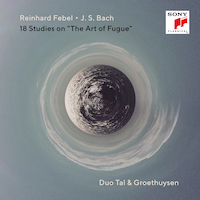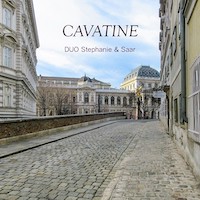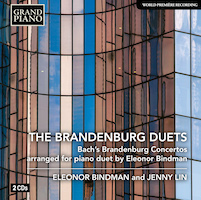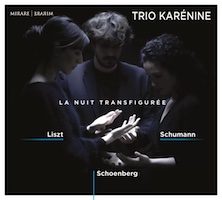Piano Factory 31. / (Dis)Arrangements 15.
|
Grant Chu Covell [June 2022.]
Reinhard FEBEL: 18 Studies for Two Pianos based on J.S. Bach’s “The Art of Fugue” (2013-14). Duo Tal & Groethuysen: Yaara Tal, Andreas Groethuysen (pno). Sony 19439784132 (2 CDs) (www.sonyclassical.de). Febel’s love letter to Bach is consummately played by Duo Tal & Groethuysen. Just as there will be those who will be horrified at Febel’s invention, there will be those who may never wish it to end. Bach’s 1740-46 Art of Fugue is a collection of fugues and canons, representing perhaps the pinnacle of Bach’s contrapuntal craft. The content is somber and regal, its instrumentation is not specified, and Bach never finished it. It has entered the repertoire in various formats, e.g.: a solo piano work, string quartet or mixed ensemble. Essentially any group that can bring life to Bach’s lines is welcome, though some prefer a consistent sound (piano, viols, strings, etc.). Febel’s intelligent handling requires two pianos. Bach’s notes are here, but Febel has added and refracted. The duo constantly interchanges voices, repeating pitches, sharing hockets (held notes and chords volley between the pianos), contributing echoes, overtones, and pedal effects. Bach’s lines continue to soar enhanced with Febel’s chiaroscuro and highlights. Sometimes it’s like hearing two recordings at once or catching something on the car radio as it’s about to fade out. This exploration also recalls performers who sing while they play, or those of us who find ourselves humming along or sculpting the air to acknowledge Bach’s contrapuntal designs. Sometimes Febel’s added overtones suggest Ravel, and the ploy Saint-Saens used in his Fifth piano concerto. Some of the layers in No. 8 suggest mechanical tricks Ligeti or Nancarrow might play. In the canons Febel adds quieter lines which stretch the tonality but still feel right. Maybe No. 17 is unexpectedly rambunctious as Febel explores the triplet’s potential and balances the heavy presentation of the main theme. The unfinished fugue (Febel’s No. 18) is expectably monumental. The B-A-C-H motif’s initial appearance chills ominously. When the music breaks away, we are left with ghostly bass notes as if broadcast from another planet.
“Cavatine.” Ludwig van BEETHOVEN: String Quartet No. 13 in B-flat Major, Op. 130 (1825-26; arr. Hugo ULRICH and Robert WITTMAN, 1890); Große Fuge, Op. 134 (1823-26; arr. BEETHOVEN, 1826). Franz SCHUBERT: Fantasie, D. 940 (1828). DUO Stephanie and Saar: Stephanie Ho, Saar Ahuvia (pno). New Focus Recordings FCR274 (1 CD) (www.newfocusrecordings.com). For all its wondrousness, Beethoven’s Op. 130 string quartet is an unusual opus, perhaps even unidiomatic, and this uniqueness carries over to the piano version. It’s not just the number of movements and unexpected design, but the alternately dense and transparent writing, and the strange logic which makes the music satisfying. Quartet No. 13 sounds sensible translated to four-hand piano but compared with Beethoven’s arrangement of the Große Fuge or Schubert’s Fantasie, it is evident that this is not keyboard music. (Honestly, the B-flat quartet is also strange for strings but that’s how we are used to hearing it.) DUO Stephanie and Saar provide the right shape, nurturing the flow, giving life to an unexpectedly justified way to experience Op. 130. Ignoring Beethoven’s Finale rewrite, the duo follows the Cavatine with Beethoven’s Große Fuge arrangement (the quartet movement was published separately from Op. 130 as Op. 133; the four-hand piano version became Op. 134). On piano the Große Fuge can be more strident whereas the quartet may soften its angularity. Beethoven’s peculiar tied and repeated eighth notes persist in his piano version. Not unlike Bach’s Art of Fugue, Beethoven’s Große Fuge is a music of ideas and whether for string quartet or four-hand piano it can be daunting and hard to hear any beauty. The duo tackles it squarely. The have taken on this repertoire before: Three Op. 18 quartets (Nos. 1, 4 and 6) appear on New Focus Recordings FCR147. Schubert and Beethoven were contemporaries, and both lived in Vienna. But they inhabited different circles, and it is believed that they never met. Schubert was in polite awe of the older composer and attended his funeral. The Fantasie is lyrical, assuredly devised at the piano and without intellectual objectives. It offers fugal writing, but Schubert is dramatic whereas Beethoven is belligerently obtuse. The Schubert ought to be the most idiomatic music of this program, but I keep coming back to Op. 130.
“The Brandenburg Duets.” Johann Sebastian BACH: Brandenburg Concertos, BWV 1046-51 (1721; arr. Eleonor BINDMAN, 2016). Eleonor Bindman, Jenny Lin (pno). Grand Piano Records GP777-78 (2 CDs) (www.grandpianorecords.com). Unsatisfied by Reger’s piano duet arrangement, which drowns the upper player with all the fast notes while the lower player steps though bass lines, Bindman created a transcription which repositions melodies and accompaniment so that each player has a fair chance at Bach’s polyphony. Perhaps not every note or voice is maintained, but the result is clear, and apparently fun to play. The Concertos are presented in the order 1, 3, 5, 6, 4 and 2, so that each disc (with three concertos each) has a shape, and that focus can be given to No. 6 which Bindman believes to be the most transformed. Soloists may push and pull at entrances which in the complex Concertos (e.g.: Nos. 1 and 2) will work when the ensemble maintains rhythmic gravity. With just four hands, the tempos must be stricter otherwise a solo line would seem like sloppy playing. It’s not immediately evident how the keyboard solo in No. 5 is handled, but it emerges organically within the four-hand texture. For No. 6 Bindman uses octave transposition to clarify the viola’s often muddled canons, and suddenly more sunlight streams through the canopy to the ground. This may be one of the few times where we wonder about Bach’s instrument choices, or perhaps we are misunderstanding the notation. Bindman and Lin take No. 6 appropriately stately.
“Jugendstil.” Gustav MAHLER: Adagietto from Symphony No. 5 (1901-02; arr. Beatrice BERRUT, 2021); Tempo di Menuetto from Symphony No. 3 (1896; arr. B. BERRUT, 2021); Andante Moderato from Symphony No. 6 (1903-04, rev. 1906; arr. B. BERRUT, 2021). Arnold SCHOENBERG: Verklärte Nacht – Paraphrase (1899; arr. B. BERRUT, 2021). Beatrice Berrut (pno). La Dolce Volta LDV100 (1 CD) (www.ladolcevolta.com). Berrut’s arrangements are not completely literal but intend to translate Mahler’s intentions into vivid transcriptions as if executed by Liszt. This means added octaves and arpeggios, and octave displacement for highlights. In early Mahler, it’s easy to hear how spinning lines (in the Third) were probably discovered at the piano, but in mid-period (and later) works, Mahler’s twisting textures are harder to simulate at a keyboard. There are a few measures in the Adagietto in every piano arrangement where a momentary dissonance stands out because the surrounding consonance, evenly sustained by strings or winds, must by nature fade away at the piano. The movements from the Third and the Sixth are appropriately light and dreamy. The Tempo di Menuetto could be a concert etude. In No. 6’s Andante moderato, the solo horn’s momentary dissonance is less striking on the piano. Berrut acknowledges borrowing accompaniment patterns from Brahms’ Klavierstücke to translate sustained string textures in the Fifth and suggesting a carillon to imitate the Sixth’s cowbells. Berrut would like us to imagine her following in Liszt’s footsteps, but I also hear deep bass lines and am reminded of Busoni whose arrangement of Schoenberg’s Op. 11, No. 2, hovers in the distance, though Berrut is more faithful. Berrut provides a Verklärte Nacht paraphrase, recognizing the difficulty of transforming the sextet into keyboard. Her paraphrase has a different shape than Schoenberg’s original because of elaborations and Romantic gestures. Here’s where Berrut’s affinity for Liszt is most evident. Arpeggio flurries, scale passages, spinning glitter circlets could have been culled from the B-minor Sonata or Années de pèlerinage. It pleases to hear Berrut find the bridge between Liszt’s quasi atonality and Schoenberg’s hyper-Romanticism. A striking moment in the sextet, where the sunshine appears and the man accepts the woman (about 0:50 into IV here) is less astonishing because Berrut already made use of similar figuration.
“La Nuit Transfigurée.” Franz LISZT: Tristia (Vallée d’Obermann) S. 723c (1880). Robert SCHUMANN: Six Studies in Canonic Form, Op. 56 (1845; trans. Theodor KIRCHNER, 1885). Arnold SCHOENBERG: Verklärte Nacht, Op. 4 (1899; trans. Eduard STEUERMANN, 1932). Trio Karénine: Paloma Kouider (pno), Fanny Robilliard (vln), Louis Rodde (vlc). Mirare MIR554 (1 CD) (www.mirare.fr). A connection between Liszt and Schoenberg appears unabashed in the Trio Karénine’s luscious program. The dry Schumann transcriptions, taking inspiration from Bach in the form of six trifling canons with piano bringing up the harmony, are sandwiched between Liszt’s arrangement of his Vallée d’Obermann, retitled Tristia, and Steuermann’s trio instrumentation of Schoenberg’s Verklärte Nacht. Steuermann was the pianist who took part in Pierrot Lunaire’s premiere. We could be forgiven for confusing Liszt and Schoenberg as both are given a similar breathless, impassioned Romantic treatment. Violin and cello are over-enthusiastic commentators, ready to get into the action. It is unexpected to hear a piece of chamber music by Liszt where the piano steps back.
Bach, Beethoven, Berrut, Bindman, Febel, Liszt, Mahler, Schoenberg, Schubert, Schumann, Steuermann, T Kirchner, Ulrich, Wittman
[More
Bach, Beethoven, Berrut, Bindman, Febel, Liszt, Mahler, Schoenberg, Schubert, Schumann, Steuermann, T Kirchner, Ulrich, Wittman]
[Previous Article:
Used Bin Troll Tweets III.]
[Next Article:
String Theory 38: Nineteen String Quartets]
|




